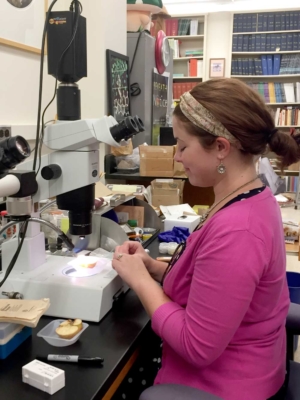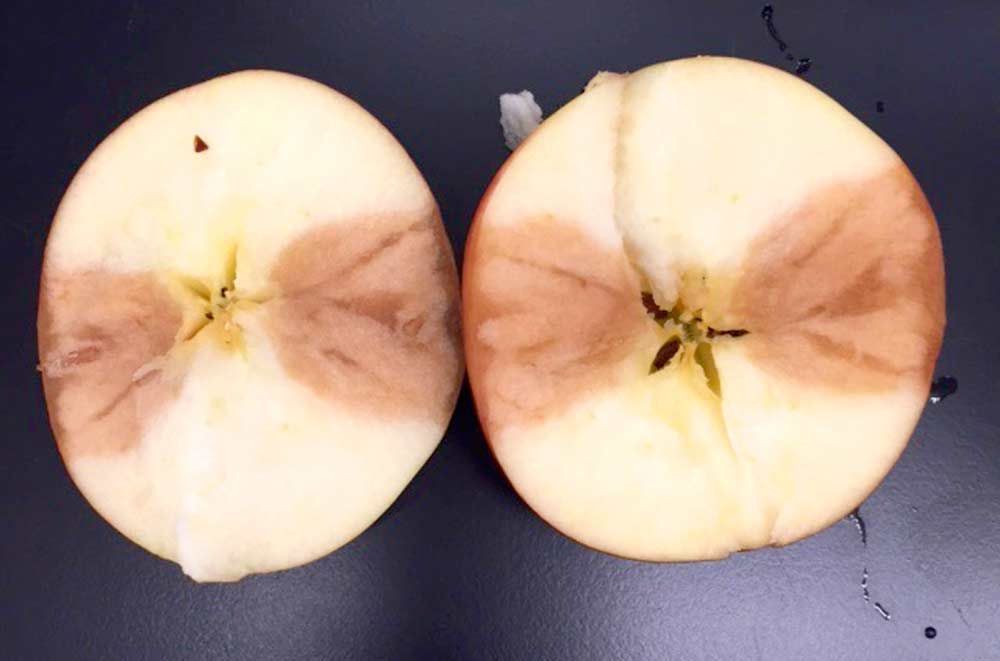
One way to distinguish paecilomyces rot from other types of similar-looking rot, is to look for rings within a circular bruise on the surface of the apple. The rings are more visible on lighter-skinned apples, such as the Golden Delicious seen here. Photo by Megan Biango-Daniels.
A never-before-known apple disease may be behind the spoilage sometimes seen in juices, concentrates, syrups and other apple products, according to a new Cornell University study.
The disease, dubbed paecilomyces rot, is caused by infection with a specific mold (Paecilomyces niveus). It looks similar to other apple diseases, including blue rot, a common postharvest apple disease that results from infection with a related type of mold (Paecilomyces expansum).
Both types of mold produce a toxin called patulin that can sicken people, but what makes P. niveus an even more insidious pathogen is that it can survive high temperatures and find its way into pasteurized apple products.

While a doctoral student at Cornell University, Megan Biango-Daniels found that a new apple disease — paecilomyces rot — may be behind the spoilage sometimes seen in juices and other apple products. (Photo courtesy Tristan Wang)
Tracking down paecilomyces rot
Paecilomyces rot came to light following some detective work and experimentation by doctoral student Megan Biango-Daniels, who was working in the lab of Kathie T. Hodge of Cornell’s Plant Pathology and Plant-Microbe Biology Section.
“I first heard about it when colleagues in food science told me about a heat-resistant mold called Paecilomyces niveus that they were finding in pasteurized food products, but no one knew how it was getting in the foods,” Biango-Daniels said.
She was intrigued. She began scouring the scientific literature for mentions of the mold and came across an old study that located it in orchard soil. Since blue-rot and other apple-disease molds were known to infect apples through injuries, she tested whether the same held true for P. niveus.
She introduced the mold to Gala and Golden Delicious apples through wounds (a prick with a mold-covered toothpick), and within a matter of three weeks, the infected apples developed brown lesions at least 1.5 inches in diameter.
By re-isolating the mold from the lesions, she verified that the apples were indeed sick from infection with P. niveus.
Through this work, she concluded that the most likely route for the mold to get into juices and other products was the following: An apple drops from a tree, incurs a wound, mold infects the apple through the wound, the apple is collected and used in processing. “From a research standpoint, it was really exciting to make the connection,” she said.
What growers need to know
Paecilomyces rot resembles several other types of rot, including apple ring rot, bull’s-eye rot, black rot and bitter rot, but it does have distinguishing features.
“For one thing, it kind of looks like a deep bruise, and on the surface, and especially with yellow or lighter-skinned apples, you can see distinct rings inside the circular lesion,” Biango-Daniels said. In addition, the bruise-like spots are firm rather than mushy.
In other words, “the tissue doesn’t melt, so it isn’t easily separable from the rest of the apple.”
So far, no definitive test is available to help growers identify paecilomyces rot disease, but a couple of options are available for finding the mold’s spores in the soil. One involves asking an extension agent to culture it “because it does look different from similar molds when you grow it in the lab,” she said.

Paecilomyces rot is caused by infection with Paecilomyces niveus, a toxin-producing mold that can survive even the high temperatures used in pasteurization. (Photo by Megan Biango-Daniels)
Biango-Daniels also developed a rather clever way of recognizing the mold’s spores in soil; she takes a mixture of soil and water and heats it to 70 degrees Celsius (158 degrees Fahrenheit) for 30 minutes.
“That kills almost everything else, but because these spores are heat resistant up to 85 degrees Celsius (185 degrees F), you’re left with it.” Using this heat method, she found P. niveus in more than a third of the orchards she tested in New York, so it is quite prevalent.
Biango-Daniels, who earned her Ph.D. in May, will be moving on to other projects, but Hodge’s lab is continuing its study of paecilomyces rot.
The lab has already begun testing to see if the mold can potentially be managed by some of the approved fungicides apple growers are already using. No recommendations are available yet, but Biango-Daniels is optimistic. “Hopefully we’ll see that it’s easily controlled,” she said.
In the meantime, she offers the following advice to growers: “Make sure that you don’t use apples that have been damaged and have had contact with the soil.” Growers already know that dropped fruit have an increased risk of spoilage and bacterial contamination, “but paecilomyces rot is something we need to be mindful of, because this mold is common in orchard soil, it can get into a wound, and it can cause problems in heat-treated apple products.” •
—by Leslie Mertz
The research described here was supported by a grant from the U.S. Department of Agriculture’s National Institute of Food and Agriculture and a Cornell College of Agriculture and Life Sciences Arthur Boller Apple Research Grant.






Leave A Comment